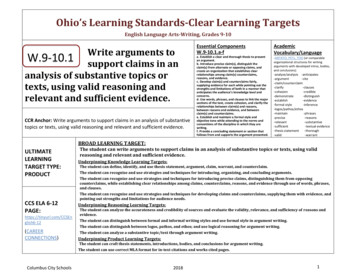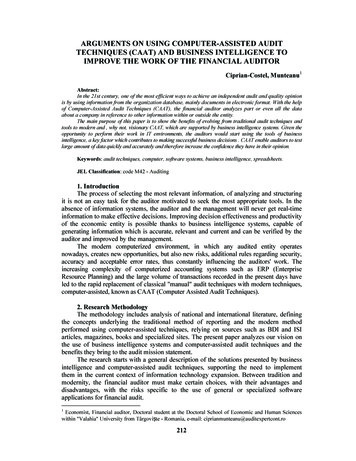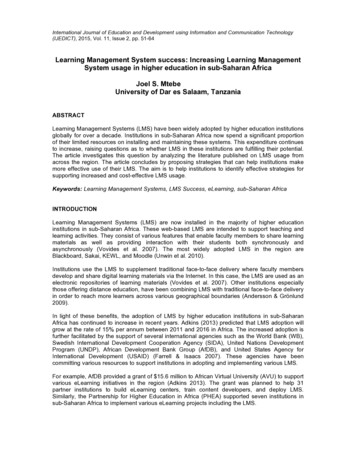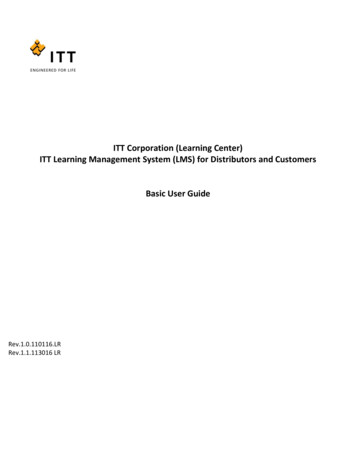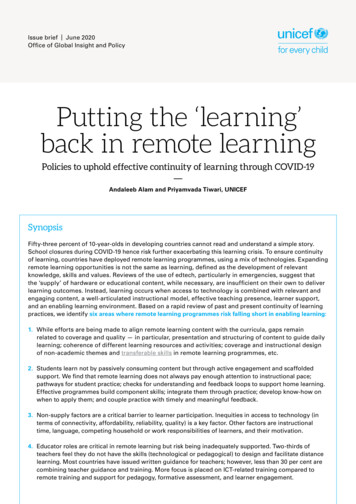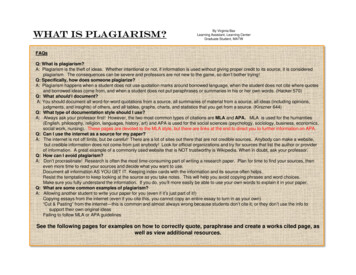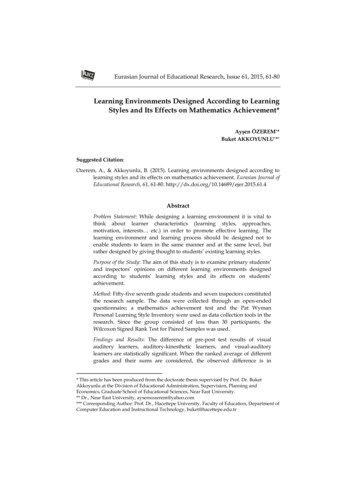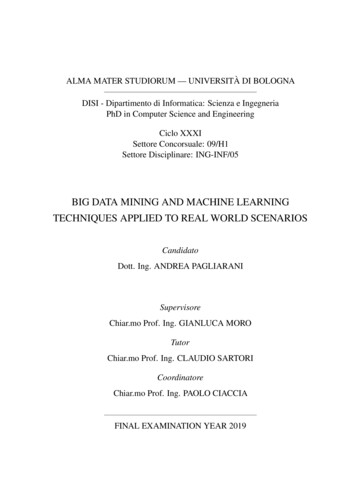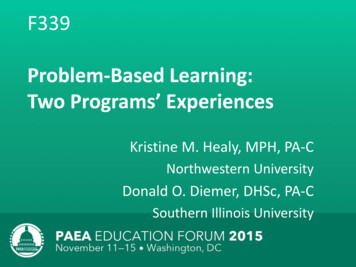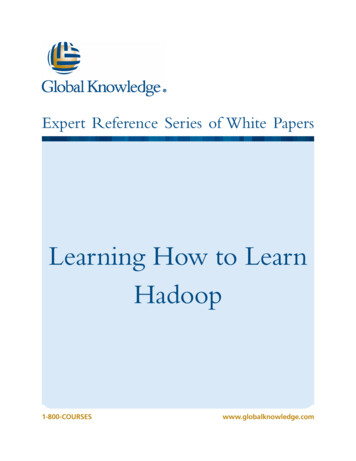
Transcription
Learning from ArgumentsAn Introduction to PhilosophyDaniel Z. KormanWinter 2022 Edition
Table of ContentsPreface for StudentsPreface for InstructorsIntroduction1. Can God Allow Suffering?2. Why You Should Bet on God3. No Freedom4. You Know Nothing5. What Makes You You6. Don’t Fear the Reaper7. Taxation is Immoral8. Abortion is Immoral9. Eating Animals is Immoral10. What Makes Things RightAppendix A: LogicAppendix B: WritingAppendix C: Theses and Arguments2
Preface for StudentsI’m going to argue that you have no free will. I’m going to argue for someother surprising things too, for instance that death isn’t bad for you,taxation is immoral, and you can’t know anything whatsoever about theworld around you. I’m also going to argue for some things you’re probablynot going to like: that abortion is immoral, you shouldn’t eat meat, and Goddoesn’t exist.The arguments aren’t my own. I didn’t come up with them. I don’t evenaccept all of them: there are two chapters whose conclusions I accept, threeI’m undecided about, and five I’m certain can’t be right. (I’ll let you guesswhich are which.) This isn’t merely for the sake of playing devil’s advocate.Rather, the idea is that the best way to appreciate what’s at stake inphilosophical disagreements is to study and engage with seriousarguments against the views you’d like to hold.Each chapter offers a sustained argument for some controversial thesis,specifically written for an audience of beginners. The aim is to introducenewcomers to the dynamics of philosophical argumentation, using some ofthe arguments standardly covered in an introductory philosophy course,but without the additional hurdles one encounters when reading theprimary sources of the arguments: challenging writing, obscure jargon, andreferences to unfamiliar books, philosophers, or schools of thought.The different chapters aren’t all written from the same perspective. Thisis obvious from a quick glance at the opening chapters: the first chapterargues that you shouldn’t believe in God, while the second argues that youshould. You’ll also find that chapters 5 and 6 contain arguments pointingto different conclusions about the relationship between people and theirbodies, and chapter 7 contains arguments against the very theory ofmorality that’s defended in chapter 10. So, you will be exposed to a varietyof different philosophical perspectives, and you should be on the lookoutfor ways in which the arguments in one chapter provide the resources forresisting arguments in other chapters.And while there are chapters arguing both for and against belief in God,that isn’t the case for other topics we’ll cover. For instance, there’s a chapterarguing that you don’t have free will, but no chapter arguing that you dohave free will. That doesn’t mean that you’ll only get to hear one side of theargument. Along the way you will be exposed to many of the standardobjections to the views and arguments I’m advancing, and you can decidefor yourself whether those objections are convincing. Those who need helpfinding the flaws in the reasoning (or ideas for paper topics) can look to thereflection questions at the end of each chapter for some clues.3
As I said, the arguments advanced in the book are not my own, and atthe end of each chapter I point out the original sources of the arguments. Insome chapters, the central arguments have a long history, and theformulations I use can’t be credited to any one philosopher in particular.Other chapters, however, are more directly indebted to the work of specificcontemporary philosophers, reproducing the contents of their books andarticles (though often with some modifications and simplifications). Inparticular, chapter 7 closely follows the opening chapters of MichaelHuemer’s The Problem of Political Authority; chapter 8 reproduces the centralarguments of Judith Jarvis Thomson’s “A Defense of Abortion” and DonMarquis’s “Why Abortion is Immoral”; and chapter 9 draws heavily fromDan Lowe’s “Common Arguments for the Moral Acceptability of EatingMeat” and Alastair Norcross’s “Puppies, Pigs, and People”.I’m grateful to Jeff Bagwell, Matt Davidson, Nikki Evans, JasonFishbein, Bill Hartmann, Colton Heiberg, İrem Kurtsal, Jeonggyu Lee,Clayton Littlejohn, David Mokriski, Seán Pierce, and Neil Sinhababu forhelpful suggestions, and to the Facebook Hivemind for help selecting thefurther readings for the various chapters. Special thanks are due to ChadCarmichael, Jonathan Livengood, and Daniel Story for extensive feedbackon a previous draft of the book, and to the students in my 2019 FreshmanSeminar: Shreya Acharya, Maile Buckman, Andrea Chavez, Dylan Choi,Lucas Goefft, Mino Han, PK Kottapalli, Mollie Kraus, Mia Lombardo, DeanMantelzak, Sam Min, Vivian Nguyen, Ariana Pacheco Lara, KaelenPerrochet, Rijul Singhal, Austin Tam, Jennifer Vargas, Kerry Wang, andLilly Witonsky. Finally, thanks to Renée Jorgensen for permission to use herportrait of the great 20th century philosopher and logician Ruth BarcanMarcus on the cover. You can see some more of her portraits ofphilosophers here: www.reneebolinger.com/portraits.html4
Preface for InstructorsLearning from Arguments is a novel approach to teaching Introduction toPhilosophy. It presents accessible versions of key philosophical arguments,in a form that students can emulate in their own writing, and with theprimary aim of cultivating an understanding of the dynamics ofphilosophical argumentation.The book contains ten core chapters, covering:1. The problem of evil2. Pascal’s wager3. Free will and determinism4. Cartesian skepticism and the problem of induction5. Personal identity6. Death7. Taxes8. Abortion (covering the violinist and future-like-ours arguments)9. The morality of meat-eating10. Ethical theory (with a focus on utilitarianism)Additionally, there is an introductory chapter explaining what argumentsare and surveying some common argumentative strategies, an appendix onlogic explaining the mechanics and varieties of valid arguments, and anappendix providing detailed advice for writing philosophy papers.Each of the ten core chapters offers a sustained argument for somecontroversial thesis, specifically written for an audience of beginners. Theaim is to introduce newcomers to the dynamics of philosophicalargumentation, using some of the arguments standardly covered in anintroductory philosophy course, but without the additional hurdles oneencounters when reading the primary sources of the arguments:challenging writing, specialized jargon, and references to unfamiliar books,philosophers, or schools of thought.Since the book is aimed at absolute beginners, I often address objectionsthat would only ever occur to a beginner and ignore objections and nuancesthat would only ever occur to someone already well-versed in these issues.Theses defended in the chapters often are not ones that I myself accept.Instead, decisions about which position is defended in the chapter weremade with an eye to pedagogical effectiveness.Instructors will find the book easy to teach from. The chapters are selfstanding with no cross-referencing, and may be taught in any order. Thecentral arguments of each chapter are already extracted in valid,premise/conclusion form, ready to be put up on the board or screen anddebated. The chapters also contain plenty of arguments that haven’t beenextracted in this way, but that are self-contained in a single paragraph,making for moderately challenging—but not too challenging—argumentreconstruction exercises. The reflection questions at the end of each chaptercan easily be incorporated into class discussion.5
The book can be used in different ways in the classroom. Instructorsmay decide to take on the persona of the author of the chapter, leaving it tothe students to find a way of resisting the arguments—which I have foundto be an enjoyable and effective way of teaching the material. Or they mayuse the arguments in the chapter as a jumping-off point for presenting thestandard positions and responses. They may wish to supplement thechapters with the original sources of the arguments or with readingsrepresenting competing philosophical positions, possibly drawn from thelist of further readings at the end of each chapter.Don’t worry about Learning from Arguments being too “one-sided”. It’strue that whichever view is being defended in the chapter always gets thelast word. But along the way, students are exposed to clear and charitablepresentations of the standard objections to the views and argumentsadvanced in the chapter, and can decide for themselves whether thechapter’s responses to those objections are convincing. Students who needhelp finding the flaws in the reasoning (or ideas for paper topics) can lookto the reflection questions at the end of each chapter for clues about themost promising places to resist the arguments.Additionally, I think instructors will find there to be significantpedagogical advantages to a “one-sided” approach. When beginners arepresented with a full menu of available views, surveying the pros and consof each, this can sometimes give the wrong impression: that, in philosophy,all views are equally defensible, that it’s all a matter of opinion, and that it’sup to you to pick and choose whichever view you like best. What theapproach in Learning from Arguments emphasizes is that it’s not that easy. Ifyou want to say that abortion is permissible or that people have free will,you have to work for it, identifying some flaw in the arguments for theopposite conclusion. In my experience, students find this sort of challengeexciting.6
IntroductionThe aim of this book is to introduce you to the topics and methods ofphilosophy by advancing a series of arguments for controversialphilosophical conclusions. That’s what I’ll do in the ten chapters thatfollow. In this Introduction, I’ll give you an overview of what I’ll be arguingfor in the different chapters (section 1), explain what an argument is(sections 2-3), and identify some common argumentative strategies(sections 4-7). I’ll close by saying a few words about what philosophy is.1. Detailed ContentsAs I explained in the preface, each chapter is written “in character”,representing a specific perspective (not necessarily my own!) on the issuein question. This is not to say that they are all written from the sameperspective. You should not expect the separate chapters to fit together intoa coherent whole. I realize that this may cause some confusion. But youshould take this as an invitation to engage with the book in the way that Iintend for you to engage with it: by questioning the claims being made anddeciding for yourself whether the reasons and arguments offered insupport of those claims are convincing.In chapter 1, “Can God Allow Suffering?”, I advance an argument thatan all-powerful and morally perfect God would not allow all the sufferingwe find in the world, and therefore must not exist. I address a number ofattempts to explain why God might allow suffering, for instance that it’snecessary for appreciating the good things that we have, or for buildingvaluable character traits, or for having free will. I also address the responsethat God has hidden reasons for allowing suffering that we cannot expectto understand.In chapter 2, “Why You Should Bet on God”, I advance an argumentthat you should believe in God because it is in your best interest: you’reputting yourself in the running for an eternity in heaven without riskinglosing anything of comparable value. I defend the argument against avariety of objections, for instance that it is incredibly unlikely that Godexists, that merely believing in God isn’t enough to gain entry into heaven,and that it’s impossible to change one’s beliefs at will.In chapter 3, “No Freedom”, I advance two arguments for theconclusion that no one ever acts freely. The first turns on the idea that all ofour actions are determined by something that lies outside our control,namely the strength of our desires. The second turns on the idea that ouractions are all consequences of exceptionless, “deterministic” laws ofnature. In response to the concern that the laws may not be deterministic, Iargue that undetermined, random actions wouldn’t be free either. Finally,7
I address attempts to show that there can be free will even in a deterministicuniverse.In chapter 4, “You Know Nothing”, I argue for two skepticalconclusions. First, I advance an argument that we cannot know anythingabout the future. That’s so, I argue, because all of our reasoning about thefuture relies on an assumption that we have no good reason to accept,namely that the future will resemble the past. Second, I advance anargument that we cannot know anything about how things presently are inthe world around us, since we cannot rule out the possibility that we arecurrently having an incredibly vivid dream.In chapter 5, “What Makes You You”, I criticize a number of attempts toanswer the question of personal identity: under what conditions are aperson at one time and a person at another time one and the same person?I reject the suggestion that personal identity is a matter of having the samebody, on the basis of an argument from conjoined twins and an argumentfrom the possibility of two people swapping bodies. I reject the suggestionthat personal identity can be defined in terms of psychological factors onthe strength of “fission” cases in which a single person’s mental life istransferred into two separate bodies.In chapter 6, “Don’t Fear the Reaper”, I advance an argument that deathcannot be bad for you, since you don’t experience any painful sensationswhile dead, and that since death is not bad for you it would be irrational tofear it. I argue that you don’t experience any painful sensations while deadby way of arguing that physical organisms cease to be conscious when theydie and that you are a physical organism. I also address the suggestion thatwhat makes death bad for you is that it deprives you of pleasantexperiences you would otherwise have had.In chapter 7, “Taxation is Immoral”, I argue that it is wrong forgovernments to tax or imprison their citizens, on the grounds that thesepractices are not relevantly different from a vigilante locking vandals in herbasement and robbing her neighbors to pay for her makeshift prison. Iaddress a variety of putative differences, with special attention to thesuggestion that we have tacitly consented to following the law and payingtaxes and thereby entered into a “social contract” with the government.In chapter 8, “Abortion is Immoral”, I examine a number of argumentsboth for and against the immorality of abortion. I argue that the questioncannot be settled by pointing to the fact that the embryo isn’t self-sufficientor conscious or rational, nor by pointing to the fact that it has human DNA,that it is a potential person, or that life begins at conception. I then examinethe argument that abortion is immoral because the embryo has a right tolife, and I show that the argument fails since having a right to life doesn’tentail having a right to continued use of the mother’s womb. Finally, I8
advance an alternative argument for the immorality of abortion, accordingto which this killing, like other killings, is wrong because it deprives itsvictim of a valuable future.In chapter 9, “Eating Animals is Immoral”, I defend the view that it isimmoral to eat meat that comes from so-called “factory farms”. I begin bycriticizing three common reasons for thinking that eating meat is morallyacceptable: because people have always eaten meat, because eating meat isnecessary, and because eating meat is natural. I then argue that eatingfactory-farmed meat is immoral, on the grounds that it would be immoralto raise and slaughter puppies in similar ways and for similar reasons.In chapter 10, “What Makes Things Right”, I advance a “utilitarian”theory of morality, according to which the rightness or wrongness of anaction is always entirely a matter of the extent to which it increases ordecreases overall levels of happiness in the world. I defend the theoryagainst the objection that it wrongly permits killing one person to save five.Along the way, I consider the ways in which morality is and isn’t subjectiveand variable across cultures, and what to say about the notorious “trolleycases”.In appendix A, “Logic”, I examine one of the features that makes anargument a good argument, namely validity. I explain what it means for anargument to be valid, and I illustrate the notion of validity by presentingand illustrating four types of valid arguments.In appendix B, “Writing”, I present a model for writing papers forphilosophy courses: introduce the view or argument you plan to criticize(section 1), advance your objections (section 2), and address likelyresponses to your objections (section 3). I explain the importance of clearand unpretentious writing that is charitable towards opposing viewpoints;I offer advice for editing rough drafts; I identify some criteria thatphilosophy instructors commonly use when evaluating papers; and Iexplain the difference between consulting online sources and plagiarizingthem.In appendix C, “Theses and Arguments”, I collect together the keyarguments and theses discussed in the book. Readers may find it helpful tohave a printed copy of this appendix at hand, or have it open in a separatetab, while reading through the chapters.2. The Elements of ArgumentsLet’s begin by having a look at what an argument is. An argument is asequence of claims, consisting of premises, a conclusion, and in some casesone or more subconclusions. The conclusion is what the argument isultimately trying to establish, or what’s ultimately being argued for. Thepremises are the assumptions that, taken together, are meant to serve as9
reasons for accepting the conclusion. A subconclusion is a claim that is meantto be established by some subset of the premises but that isn’t itself theultimate conclusion of the argument.As an illustration, consider the following argument:Against Fearing Death(FD1) You cease to be conscious when you die(FD2) If you cease to be conscious when you die, then being dead isn’tbad for you(FD3) So, being dead isn’t bad for you(FD4) If being dead isn’t bad for you, then you shouldn’t fear death(FD5) So, you shouldn’t fear deathThe argument has three premises: FD1, FD2, and FD4. FD5 is the conclusionof the argument, since that’s what the argument is ultimately trying toestablish. FD3 is a subconclusion. It isn’t the conclusion, since the ultimategoal of the argument is to establish that you shouldn’t fear death, not thatbeing dead isn’t bad for you (which is just a step along the way). Nor is it apremise, since it isn’t merely being assumed. Rather, it’s been argued for: itis meant to be established by FD1 and FD2.In this book, you can always tell which claims in the labeled andindented arguments are premises, conclusions, and subconclusions. Theconclusion is always the final claim in the sequence. The subconclusions areanything other than the final claim that begins with a “So”. Any claim thatdoesn’t begin with “So” is a premise. However, when it comes to unlabeledarguments—arguments appearing in paragraph form—all bets are off. Forinstance, I might say:Death isn’t bad for you. After all, you cease to be conscious when youdie, and something can’t be bad for you if you’re not even aware of it.And if that’s right, then you shouldn’t fear death, since it would beirrational to fear something that isn’t bad for you.The paragraph begins with a subconclusion, the conclusion shows up rightin the middle of the paragraph, and neither of them is preceded by a “So”.Here, you have to use some brain-power and clues from the context tofigure out which bits are the basic assumptions (the premises), which bit isthe conclusion, and which bits are mere subconclusions.All of the labeled arguments in the book are constructed in such a waythat the conclusion is a logical consequence of the premises—or, as Isometimes put it, the conclusion “follows from” the premises. You may ormay not agree with FD1, and you may or may not agree with FD2. But what10
you can’t deny is that FD1 and FD2 together entail FD3. If FD3 is false, thenit must be that either FD1 or FD2 (or both) is false. You would becontradicting yourself if you accepted FD1 and FD2 but denied FD3.Because all the arguments are constructed in this way, you cannot reject theconclusion of any of the labeled arguments in the book while agreeing withall of the premises. You must find some premise to deny if you do not wantto accept the conclusion. (See Appendix A, “Logic”, for more on how to tellwhen a conclusion is a logical consequence of some premises.)3. Premises and ConditionalsThere are no restrictions on which sorts of statements can figure as premisesin an argument. A premise can be a speculative claim like FD1 or aconceptual truth like FD4. A premise can also be a statement of fact, forinstance that a six-week-old embryo has a beating heart, or it can be a moraljudgment, for instance that a six-week-old embryo has a right to life.Arguments can have premises that are mere matters of opinion, for instancethat mushrooms are tasty. They can even have premises that are utterly andobviously false, for instance that the sky is yellow or that 1 1 3. Anythingcan be a premise.That said, an argument is only as strong as its premises. The point ofgiving an argument is to persuade people of its conclusion, and anargument built on dubious, indefensible, or demonstrably false premises isunlikely to persuade anyone.Arguments frequently contain premises of the form “if then ”, likeFD2 and FD4. Such statements are called conditionals, and there are namesfor the different parts of a conditional. The bit that comes between the ‘if’and the ‘then’ is the antecedent of the conditional, and the bit that comesafter the ‘then’ is the consequent of the conditional. Using FD2 as anillustration, the antecedent is you cease to be conscious when you die, theconsequent is being dead is not bad for you, and the conditional is the wholeclaim: if you cease to be conscious when you die then being dead is not bad for you.(Strictly speaking, conditionals don’t have to be of the form “if then ”. They can also be of the form “ only if ”, as in “You should feardeath only if being dead is bad for you”, or of the form “ if ”, as in “Youshouldn’t fear death if being dead isn’t bad for you”.)Conditionals affirm a link between two claims, and you can agree thatsome claims are linked in the way a conditional says they are, even if youdon’t agree with the claims themselves. To see this, consider the followingargument:11
The Drinking Age Argument(DK1) Kristina is twenty years old(DK2) If Kristina is twenty years old, then Kristina is not allowed to buyalcohol(DK3) So, Kristina is not allowed to buy alcoholYou might object to this argument because you think that Kristina is 22 andthat she is allowed to buy alcohol. Still, you should agree with theconditional premise DK2: you should agree that being 20 years old andbuying alcohol are linked in the way DK2 says they are. You should agreethat DK2 is true even though you disagree with both its antecedent and itsconsequent. To deny DK2, you’d have to think, for instance, that the legaldrinking age was 18. But if you agree that the legal drinking age is 21, thenyour quarrel is not with DK2; it’s with DK1.Likewise, you can agree with the conditional premise FD4 even if youthink that being dead is bad for you. To disagree with FD4, you’d have tothink that it’s sometimes rational to fear things that aren’t bad for you.4. Common Argumentative StrategiesArguments can play a variety of different roles in philosophical debates.Let’s have a look as some common argumentative strategies that you’llencounter in the book.First, an argument can be used to defend a premise from anotherargument. Premise FD1 of the Against Fearing Death argument—that youcease to be conscious when you die—is hardly obvious. So, someone wholikes the Against Fearing Death argument might try to produce a furtherargument in defense of that premise, like the following:The Brain Death Argument(BD1) Your brain stops working when you die(BD2) If your brain stops working when you die, then you cease to beconscious when you die(FD1) So, you cease to be conscious when you dieNotice that in the context of the Brain Death Argument FD1 is a conclusion,whereas in the context of the Against Fearing Death argument it’s a premise.Which role a given statement is playing can vary from one argument to thenext. And whenever one wants to deny a claim that’s a conclusion of anargument, one must identify some flaw in that argument. That means thatanyone who planned to resist the Against Fearing Death argument bydenying FD1 now has to reckon with this Brain Death Argument.12
Second, an argument can be used to challenge another argument. Thereare two ways of doing so. One would be to produce an argument for theopposite conclusion. For instance, one might advance the followingargument against FD5:The Uncertain Fate Argument(UF1) You don’t know what will happen to you after you die(UF2) If you don’t know what will happen to you after to die, then youshould fear death(UF3) So, you should fear deathNotice that UF3 is a denial of the conclusion of the Against Fearing Deathargument. Thus, if the Uncertain Fate Argument is successful, thensomething must go wrong in the Against Fearing Death argument, though itwould still be an open question where exactly it goes wrong.Another way to challenge an argument is to produce a new argumentagainst a premise of the argument you wish to challenge. Here, for instance,is an argument against FD1 of the Against Fearing Death argument:The Afterlife Argument(AF1) You go to heaven or hell after you die(AF2) If you go to heaven or hell after you die, then you don’t cease tobe conscious when you die(AF3) So, you don’t cease to be conscious when you dieUnlike the Uncertain Fate Argument, The Afterlife Argument challenges apremise of the Against Fearing Death argument, and does indicate wherethat argument is supposed to go wrong.I don’t mean to suggest that these are especially good arguments. Notall arguments are created equal! People who believe in the afterlife aren’tlikely to be convinced by the Brain Death Argument, and people who don’tbelieve in the afterlife aren’t likely to be convinced by the AfterlifeArgument. As you read on, you’ll discover that a lot of the work inphilosophy involves trying to construct arguments that will be convincingeven to those who aren’t initially inclined to accept their conclusions.5. CounterexamplesArguments often contain premises which contend that things are always acertain way. For instance, someone who is pro-life might advance thefollowing argument:13
The Beating Heart Argument(BH1) A six-week-old embryo has a beating heart(BH2) It’s always immoral to kill something that has a beating heart(BH3) So, it’s immoral to kill a six-week-old embryoThe second premise, BH2, says that killing things that have beating heartsis always immoral. Put another way, the fact that something has a beatingheart is sufficient for killing it to be immoral.Arguments also often contain premises which contend that things arenever a certain way. For instance, someone who is pro-choice might advancethe following argument in defense of abortion:The Consciousness Argument(CN1) A six-week-old embryo isn’t conscious(CN2) It’s never wrong to kill something that isn’t conscious(CN3) So, it isn’t wrong to kill a six-week-old embryoThe second premise, CN2, says that killing things that aren’t conscious isnever wrong. Put another way, in order for a killing to be wrong, it’snecessary for the victim to be conscious at the time of the killing.When a premise says that things are always a certain way or that they’renever a certain way, it’s making a very strong claim. And one can challengesuch a claim by coming up with counterexamples, examples in which thingsaren’t the way that the premise says things always are, or in which thingsare the way that the premise says things never are. For instance, you mightchallenge BH2 by pointing out that worms have hearts, and it isn’t immoralto kill them. And you might challenge CN2 by pointing out that it’s wrongto kill someone who’s temporarily anesthetized, even though they’reunconscious. In other words, worms are counterexamples to BH2 andanaesthetized people are counterexamples to CN2.These counterexamples can then be put to work in arguments of theirown, for instance:The Worm Argument(WA1) If it’s always immoral to kill something that has a beating heart,then it’s immoral to kill worms(WA2) It isn’t immoral to kill worms(WA3) So, it isn’t always immoral to kill something that has a beatingheart14
The Temporary Anesthesia Argument(TA1) If it’s never wrong to kill something that’s unconscious, then itisn’t wrong to kill a temporarily anesthetized adult(TA2) It is wrong to kill a temporarily anesthetized adult(TA3) So, it is sometimes wrong to kill something that’s unconsciousArgument by counterexample is a very common argumentative strategy,and we’ll see many examples in the different chapters of the book.It’s important to realize that these arguments do not require saying thatembryos are in every way analogous to worms or to temporarilyanesthetized adults, or that killing an embryo is the moral equivalent ofkilling a worm or a temporarily anesthetized adult. The arguments fromcounterexamples formulated above don’t say anything at all aboutembryos. Rather, they’re giving independent reasons for rejecting thatgeneral principles (BH2 and CN2) being employed in the Beating HeartArgument and the Consciousness Argument.One last thing. You’ll sometimes encounter claims in the book thatinclude the phrase “if and only if”. For instance, later on in the book we’lladdress the que
The book contains ten core chapters, covering: 1. The problem of evil 2. Pascal’s wager 3. Free will and determinism 4. Cartesian skepticism and the problem of induction 5. Personal identity 6. Death 7. Taxes 8. Abortion (covering the violinist and futur
